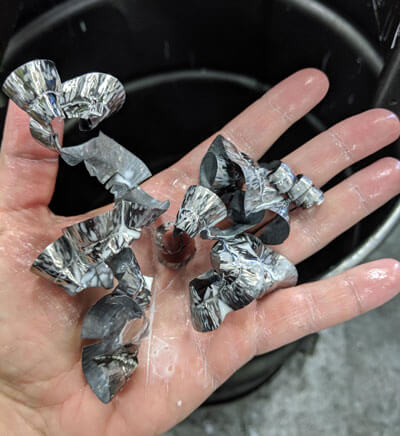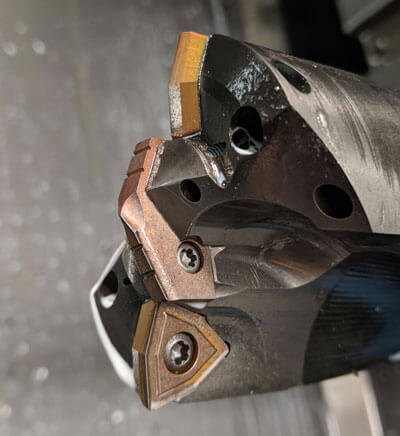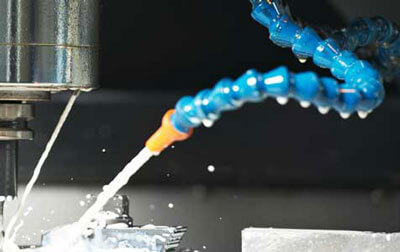Catching ‘22’: Beat the Challenges of Titanium
Read on the following sites:
In the Cut
Effectively machining titanium, an element with the atomic number 22, begins by having the proper cutting tools. One toolmaker with offerings targeted at titanium is Allied Machine & Engineering Corp., Dover, Ohio. Other than Allied’s 4TEX indexable carbide drill, the best option for drilling titanium, according to Field Sales Engineer Nate Craine, is Allied’s APX drill with a special replaceable insert.
Although some machinists consider titanium a heat-resistant superalloy, that’s not the case. “A lot of people like to lump titanium into the same category as high-temp alloys, but it’s its own breed of material that needs to be treated differently,” Craine said.
He emphasized it’s critical to understand that friction and inadequate chip evacuation cause titanium to workharden while being drilled. As a result, a titanium workpiece with a hardness of 32 HRC might workharden to 50 HRC inside the hole, which makes every process that follows drilling more complicated. “You could potentially destroy a boring tool,” Craine said.


During tool life testing at a customer’s facility, this 2.5"-dia. drill produced six holes per T-A insert for a total length of 90" and two to three holes/edge with a –PWHR insert or four to six holes/edge with a –PW insert when drilling Timetal 17 (Ti5Al2Sn4Mo2Zr4Cr) with a hardness of 34 HRC at a cutting speed of 82 sfm and a feed rate of 0.0035 ipr. The high-strength, deep-hardenable forging alloy is primarily used for jet engines. According to Allied Machine, chip formation was much better when drilling at 131 sfm and 0.0055 ipr, but tool life can drop if the machining parameters are excessive. Images courtesy of Allied Machine & Engineering
One way to help avoid that problem is by selecting a tool with the proper relief angle so it doesn’t rub against the workpiece material. “In titanium, you have the propensity for the material to pinch the side of the drill, so we developed a geometry designed for greater success,” Craine said.
Although that application-specific design requires the drill to run at a lighter feed rate, most titanium aerospace applications, for example, don’t have a need for speed, Craine added. “The material costs are more of a concern. If you can get that job done without damaging the part, then that’s a success.”
In addition to the relief angle, a drill must have the correct rake angle and hone to effectively cut titanium, noted Kevin Vanderbeck, East Coast field engineer for Allied Machine.
However, producing a cutting edge with the correct hone is a balancing act, according to Craine. Too much of a hone and the tool performs like it is dull, while an edge that is too sharp is prone to chipping.
To further enhance its T-A drills, Vanderbeck said Allied Machine performs a proprietary process “affectionately called the ultragrind” to create the ideal cutting edge for increased tool life and chip control. “That process minimizes fracture points along the cutting edge,” he added.
Without proper chip formation, titanium chips can become like ribbons and hard to evacuate. “If you are drilling anything more than three times diameter, that long ribbon will bind up and seize your tool,” Vanderbeck said. “It goes bad real quick, and a lot of times you don’t have time to hit that e-stop. By the time you see it, it is too late.”
Keep It Cool
Tool coatings and coolant play important roles when combating the high level of heat generated from cutting titanium. For coatings, Vanderbeck recommends TiAlN or Allied Machine’s proprietary AM200 or AM300. The advantage of AM200, he noted, is that the coating achieves the same level of lubricity to overcome built-up edge as TiAlN but at a lower temperature. Craine added that Allied Machine offers polished inserts with AM300 coating to minimize the chance of titanium sticking to the coating.

But without an ample supply of coolant, even the most heat-resistant coating will struggle. “The more coolant you can get, the better,” Craine said, adding that it must be a water-soluble solution instead of oil because titanium is flammable. For that same reason he also recommends that the coolant be delivered through the tool. “I’ve drilled a one-times-diameter hole with flood coolant, but that is as deep as I would go in most circumstances.”
Although one East Coast manufacturer running straight oil as coolant didn’t have problems with flammability, the company definitely wasn’t achieving optimum results. Oil is necessary for lubricity and reduction in friction, but water is also important as it pulls remaining heat away from the cutting zone.”
Once Vanderbeck’s New England-based customer switched to a water-soluble coolant, it achieved longer tool life than when the company originally had started using straight oil, he added. “Tool life is much longer and more stable, and their chiller isn’t working as hard as it once was when they used oil and struggled to manage the dissipation of the heat.”
Vanderbeck pointed out it’s essential to maintain coolant at the correct concentration, which is a bit higher for titanium applications. “I strongly recommend that manufacturers consult their coolant supplier for the best coolant concentration for their titanium applications.”
(Click here to read the full length article at Cutting Tool Engineering)